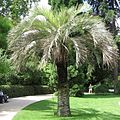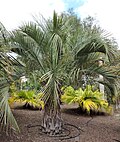

| Butia | |
|---|---|

| |
| Butia odorata | |
| Scientific classification | |
| Kingdom: | Plantae |
| Clade: | Tracheophytes |
| Clade: | Angiosperms |
| Clade: | Monocots |
| Clade: | Commelinids |
| Order: | Arecales |
| Family: | Arecaceae |
| Subfamily: | Arecoideae |
| Tribe: | Cocoseae |
| Genus: | Butia (Becc.) Becc.[1] |
| Type species | |
| Butia capitata
| |
Butia is a genus of palms in the family Arecaceae, native to the South American countries of Brazil, Paraguay, Uruguay and Argentina.[2] Many species produce edible fruits, which are sometimes used to make alcoholic beverages and other foods. The name is derived from a Brazilian vernacular word for members of the genus.[3]
These are 'feather palms', having pinnate leaves up to 3m long including petiole which usually have a distinct downward arch. The species vary from nearly stemless plants rarely exceeding 40 cm tall (e.g. Butia campicola) to small trees up to 12m tall (e.g. B. yatay).
Butia odorata is notable as one of the hardiest feather palms, tolerating temperatures down to about −10 °C; it is widely cultivated in warm temperate to subtropical regions.
| Image | Scientific name | Distribution |
|---|---|---|
 |
Butia archeri (Glassman) Glassman | Goiás, Brasília, Minas Gerais, São Paulo |
| Butia arenicola (Barb.Rodr.) Burret | Mato Grosso do Sul, Paraguay | |
| Butia campicola (Barb.Rodr.) Noblick | Mato Grosso do Sul, Paraguay | |
 |
Butia capitata (Mart.) Becc. | Minas Gerais, Goiás, Bahia |
| Butia catarinensis Noblick & Lorenzi | Rio Grande do Sul, Santa Catarina | |
 |
Butia eriospatha (Mart. ex Drude) Becc. – Woolly butia palm[7] | Paraná, Rio Grande do Sul, Santa Catarina |
| Butia exilata Deble & Marchiori | Rio Grande do Sul | |
| Butia exospadix Noblick | Mato Grosso do Sul, Paraguay | |
 |
Butia lallemantii Deble & Marchiori | Rio Grande do Sul, Uruguay |
| Butia lepidotispatha Noblick | Mato Grosso do Sul, Paraguay | |
| Butia leptospatha (Burret) Noblick | Mato Grosso do Sul, Paraguay | |
| Butia marmorii Noblick | Alto Paraná in Paraguay | |
| Butia matogrossensis Noblick & Lorenzi | Mato Grosso do Sul | |
| Butia microspadix Burret | Paraná, São Paulo | |
 |
Butia odorata (Barb.Rodr.) Noblick – South American jelly palm,[1] jelly palm,[1][7] pindo palm[1] | Rio Grande do Sul, Uruguay |
 |
Butia paraguayensis (Barb.Rodr.) L.H.Bailey – Dwarf yatay palm[7] | Brazil, Argentina, Paraguay, Uruguay |
| Butia pubispatha Noblick & Lorenzi | Paraná | |
| Butia purpurascens Glassman | Goiás, Minas Gerais | |
| Butia witeckii K.Soares & S. Longhi | Rio Grande do Sul | |
 |
Butia yatay (Mart.) Becc. – Jelly palm,[1][7] yatay palm[1][7] | Rio Grande do Sul, Uruguay, Argentina |
No longer accepted species:[4][5]
| Butia |
|
|---|---|